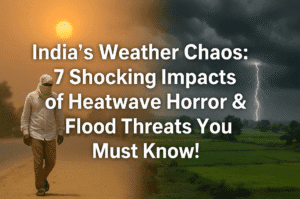India’s Weather Chaos: 7 Shocking Impacts of Heatwave Horror & Flood Threats You Must Know!
India is experiencing a stark weather divide as scorching heat grips the north and west while heavy rains threaten the east. Rajasthan, Gujarat, and parts of Madhya Pradesh face extreme heatwaves, with temperatures soaring above 44°C, causing a surge in heat-related illnesses. In contrast, eastern states like Assam, Meghalaya, and Odisha brace for torrential rains and thunderstorms, disrupting farming and daily life. Delhi’s heatwave has led to increased reliance on cooling systems, raising concerns about power demand.
The IMD attributes these conditions to cyclonic and high-pressure systems, highlighting India’s vulnerability to climate extremes. As the heat intensifies and rains disrupt the region, adaptive measures become increasingly crucial.

India’s Weather Chaos: 7 Shocking Impacts of Heatwave Horror & Flood Threats You Must Know!
As India’s summer intensifies, starkly contrasting weather patterns are unfolding across the nation. While northwestern and western states battle blistering heatwaves, eastern and northeastern regions prepare for torrential rains and thunderstorms, according to the India Meteorological Department (IMD).
Heatwave Red Alert: Survival Mode in Rajasthan, Gujarat
- Severe Heatwave Conditions: West Rajasthan faces peak temperatures of 44–46°C from April 16–18, with nighttime lows offering little respite.
- Expanding Impact: East Rajasthan, Gujarat, and parts of West Madhya Pradesh report isolated heatwaves, with temperatures 4–6°C above normal.
- Human Toll: Hospitals in Barmer and Jaisalmer report a 30% spike in heat-related illnesses. Authorities advise limiting outdoor work between 11 AM–4 PM and prioritizing hydration.
Delhi’s Sweltering Start
The capital recorded a minimum temperature of 23.4°C (1.8°C above average), with daytime highs expected at 37°C. Despite moderate humidity (50%), air quality remains in the ‘moderate’ range (AQI 184). Residents report increased reliance on cooling appliances, raising concerns about power demand.
Eastern India: Flood Risks and Farming Woes
- Heavy Rainfall Alert: Assam and Meghalaya brace for 8–12 cm rainfall on April 16, shifting to Nagaland, Manipur, Mizoram, and Tripura by April 17.
- Thunderstorm Threats: Bihar, Gangetic West Bengal, Jharkhand, and Odisha may experience 50–60 kmph winds, disrupting travel and damaging crops.
- Farmer Anxiety: Odisha’s Katak region, which saw 8 cm rainfall Tuesday, faces delays in mango harvesting. “Unseasonal rains could ruin yields,” warns local agriculturist Ramesh Patnaik.
Southern Mix: Humidity and Showers
- Bengaluru’s Relief: A partly cloudy sky with possible rain brings hope for cooler days after weeks of dry heat.
- Coastal Discomfort: Kerala, Tamil Nadu, and Coastal Karnataka endure ‘feels-like’ temperatures of 42–45°C due to high humidity, straining daily life.
Why This Weather Whiplash?
IMD experts attribute the split to:
- A cyclonic circulation over Bangladesh driving moisture into the northeast.
- A high-pressure zone over Rajasthan, trapping hot, dry air.
- Westerly winds carrying heat from Pakistan into northwest India.
Safety First: IMD’s Advisory
- For Heatwaves: Use ORS, wear lightweight clothing, and check on vulnerable neighbors.
- For Storms: Secure loose objects, avoid standing under trees, and monitor flood alerts.
Looking Ahead
While northwest India’s heatwave may ease slightly after April 18, eastern rains are expected to persist, signaling an early pre-monsoon surge. Meanwhile, Delhi’s partial cloud cover offers a hint of respite, but relief from the heat remains elusive.
Insight: These extremes underscore India’s climate vulnerabilities. As heatwaves grow longer and rains turn erratic, adaptive measures—from urban heat action plans to storm-resistant crops—are no longer optional but essential for survival.
You must be logged in to post a comment.